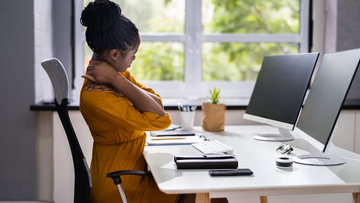Whether you work in an office, warehouse, or construction site, most jobs have physical demands and possible physical risks. Potential danger on the job, also known as an ergonomic hard, differs depending on the job, working environment, and company. Being aware of the physical risks of your job can help reduce resulting physical issues.
We’ve covered some of the top ergonomic hazards and the best ways to reduce or prevent them.
Excessive Noise
High-pitched or continuous loud noise can cause hearing loss, headaches, and tension. Construction sites, heavy equipment operators, musicians, and staff at event venues are most likely to experience prolonged noise exposure. Here are a few ways to prevent long-term hearing damage from noise exposure:
- Wear hearing protection: Earplugs and noise-blocking headphones can help reduce noise. Make sure they fit correctly.
- Monitor noise levels: Most construction sites measure noise levels to target reduction interventions.
Repetitive Motion
 Repetitive motions can cause repetitive strain injuries such as carpal tunnel syndrome. While many people think of factory work as repetitive, working on a computer and “mousing” is also repetitive. To avoid injuries from repeated movements, consider:
Repetitive motions can cause repetitive strain injuries such as carpal tunnel syndrome. While many people think of factory work as repetitive, working on a computer and “mousing” is also repetitive. To avoid injuries from repeated movements, consider:
- Taking breaks: Short, frequent breaks allow you to rest and stretch. Consider setting an alarm or using an app to remind you to stop and stretch every 45 minutes. If you are working at a computer, get up and walk around. Rotate your wrists and stretch your neck.
- Mix-up tasks: While getting everything done at once is very tempting, alternating tasks can help reduce the risk of injury and encourage you to use different muscles.
- Add Variation to your Job: Rotate between jobs whenever possible.
Lifting with Poor Form
If your job requires you to lift boxes or objects regularly, proper lifting form can significantly reduce the chance of back injury. In addition to being aware of the weight you are lifting, consider:
- Team-Lift: Use two people to lift heavier or awkwardly shaped boxes or objects.
- Wear Safe Shoes: Wear shoes with good traction and stand with feet shoulder- width apart.
- Use Your Knees: Instead of bending at the waist, bend your knees and squat down to lift. This position keeps your back straight.
- Wear Back Support: If you suffer from a weak or painful back, consider wearing a back support to reduce strain.
Sitting for Extended Periods
Individuals who work at a computer are at significant risk from sitting for extended periods. Sitting can increase the risk of blood clots, hip and back tension, poor posture and spinal pain, and neck issues. There are a few excellent ways to reduce risks associated with sitting for extended periods:
- Standing Desks: Standing desks give you the option to sit or stand. Ideally, you should switch back and forth throughout the day.
- Set a Stand Timer: Use an app or a timer to remind you to stand up and walk around.
- Yoga Balls: Switch your desk chair for a yoga ball. A yoga ball will help build core strength and encourage more movement than a traditional desk chair.






















